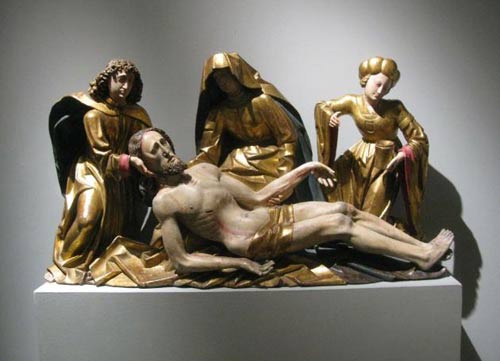
 Sculpture News at SculptSite.com
Sculpture News at SculptSite.com
Hans Schnatterpeck Sculpture |
| StarTribune.com by: MARY ABBE The Minneapolis Institute of Arts adds an important 500-year-old religious sculpture to its collection.Hans Schnatterpeck Sculpture - "The Lamentation of Christ" circa 1490 ADHovering over the wounded body of their god-in-human-form, three medieval figures give silent testimony to their grief in a sculpture acquired last week by the Minneapolis Institute of Arts. Known as "The Lamentation of Christ," the 4-foot-wide sculpture was carved from pine and painted about 1490 by an Austrian artist, Hans Schnatterpeck. Brows furrowed in sympathetic pain and sorrow, John the Evangelist, Mary the mother, and Mary Magdalene gaze at Jesus' gaunt and graying face, hold his head, reach out to cradle him. Their taut faces and pinched lips suggest the stoic reserve of those who have often known death but are not reconciled to its inevitability. Hence the tears. Sinking gracefully into a half-crouch at Jesus' feet, Mary Magdalene has the delicate poise of a ballerina who is simultaneously reaching down and pulling away, her ambivalence driven by the tremulous sorrow that shimmers in her reddened eyes and falls in a single tear. Half hooded by a flowing cape, the eyes of Mary the mother are red-rimmed too, as are those of the disciple who gently supports Jesus' head.Finding a visual language for grief Now known only to connoisseurs, Schnatterpeck (1472-1510) was a master carver from the Tyrolean mountains, where artisans of the era had achieved a rare delicacy and expressiveness in an otherwise pedestrian medium. "Finding a new [visual] language for the expression of grief was one of the great accomplishments of these northern European artists," said Eike Schmidt, the museum's sculpture curator, who spied the piece at an international art fair in the Netherlands this spring and persuaded the institution's trustees to purchase it for an undisclosed sum. Emotions were very stylized in most European sculpture before about 1500, Schmidt said. Figures would be depicted making rhetorical gestures that signified emotional states -- hands clasped before the chest or fingers touching a cheek would mean sorrow even while the faces retained a masklike calm. Schnatterpeck's more famous contemporaries, including marble-worker Michelangelo in Italy and wood carver Tilman Riemenschneider in Germany, introduced an expressive new naturalism in gesture, posture and poses. In "Lamentation," Schnatterpeck also nicely deployed the painted tear, a device invented earlier in the century by the Flemish artist Rogier van der Weyden. Following Tyrolean fashion of the time, Schnatterpeck painted and gilded the "Lamentation" figures. The pale flesh and stained eyes of the living contrast with Christ's pallor and bloody wounds. His brutalization is further dramatized by a swollen lump of flesh above the nail hole in his foot, a grisly reminder of how his body would have slumped on the cross. That unflinching and somewhat ghoulish naturalism, coupled with the figures' agitated drapery, heightens the psychological and spiritual impact of the piece. Its aesthetic value is greatly enhanced by its original paint and luxurious gilding. The color was stripped from many such sculptures during the 19th century when museums and collectors preferred natural wood. "People then wanted to be true to the material, not to the period," Schmidt said. Gap in the museum's collection The purchase fills an important gap in the collection of the institute, which has no Tyrolean work and little if any Late Gothic sculpture. Following a long-established buying strategy, the museum is trying to snap up important pieces in fields that are currently unfashionable and therefore less costly. In the first half of the 20th century, Late Gothic wood sculpture was highly prized with prices to match, Schmidt said, but after World War II it lost its cachet. Recently, however, the tide began to turn again. In 2008 a saint carved by the always admired Riemenschneider (1460-1531) set the record when it fetched $6.3 million at Sotheby's. The Schnatterpeck has a curious history of its own. For nearly a century it was owned by a museum in Innsbruck, Austria, but in 1980 it was exchanged, along with 12 other pieces, for a madonna attributed to Riemenschneider. Ironically, that madonna was subsequently downgraded to "school of Riemenschneider," a much less desirable pedigree. Although institute officials declined to say what they paid for the Schnatterpeck, Schmidt did allow that "you could say it was less than a 10th the price of the Riemenschneider." |
 This beautiful sculpture is over 500 years old. Wishing everone a Happy Easter. |
 Carved and painted about 1490 by Hans Schnatterpeck, "The Lamentation of Christ" is a dynamic Late Gothic expression of Christian piety and grief including such realistic touches as painted tears and bloodstains. |
More Sculpture News ....
Submit your SCULPTURE NEWS.
It's easy, just send us an e-mail
(click on Submit News in the left menu) with your pertinent information along with images, we'll take care of the rest. Sculpture makes our world a much better place in so many ways!
SculptSite.com, along with Sculptors and their creative genius all helping to bring the beauty and message of Sculpture to a hurried world.

